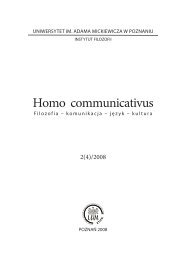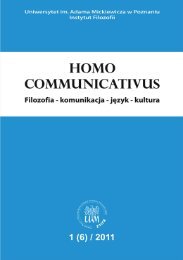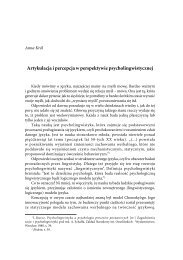72MARIETTA RADOMSKAexpectations” and as a result enjoy much more our contact with animal others. Owingto Estonian born German biologist Jakob von Uexküll (1864-1944) and his theory ofmeaning considering animals as interpreters, every living organism has its Umwelt,its subjectively interpreted environement, its phenomenal world. As he wrote in TheTheory of Meaning dated 1940 (reviewed in 1982): ”Every action that consists ofperception and operation imprints its meaning on the meaningless object and therebymakes it into a subject-related meaning-carrier in the respective umwelt” 4 . No wonderhis work has become inspiration for e.g. Konrad Lorenz, Thomas A. Sebeok, WilfriedNoth, etc. and the growth of the new disciplines such as ethology, biosemiotics,ecosemiotics and zoosemiotics.The aim of this paper is to gain a brief insight into possibilities of holdingintercourse with animal others, mainly considering the issue of zoosemiotics as“the study of the semiotic behaviour of animals, transdisciplinary field of research.Situated between biology and anthropology, it investigates a domain locatedbetween nature and culture” 5 and eventually stating a question of zoomusicologyas a field of the latter examining musical aspects of sound or communicationproduced and received by animals.Basic distinctionsFirst and foremost we draw a distinction between disciplines closely connectedwith each other, i.e. biosemiotics, ecosemiotics and of course, zoosemiotics.Biosemiotics may be defined as the interdisciplinary study of communicationand signification in living systems. As such, it is concerned with all processes goingon in animate nature at whatever level, from the single cell to the ecosystem, shouldbe analysed and conceptualised in terms of their character of being sign-processes. 6Moreover, it is not one of the biological sub-diciplines but rather it constitutes thetheoretical framework for biosciences. In terms of nature’s sign universe,biosemiotics interprets it according to Charles Sanders Peirce’s semiotic tradition,considering a sign as a triadic unity of the sign vehicle, the interpretant and theobject. In the biosemiotic perspective, the life sphere is pervaded by semiosis (signprocesses) and signification. Therefore, anything an organism senses also has somemeaning to it (e.g. food, danger) – thus every organism is born into the world ofmeaning and communication: into semiosphere, which constitutes boundaryconditions of the Umwelts of particular populations as they are to occupy specific4Jesper Hoffmeyer, The Semiosic Body-Mind, [in:] Cruzeiro Semiótico, No 22/25, Norma Tasca(ed.) Special Issue in Honour of Professor Thomas A. Sebeok, pp. 367-383. Also available on website:http://www.molbio.ku.dk/MolBioPages/abk/PersonalPages/Jesper/Semiosic.html5Wilfried Noth, Handbook of semiotics, Bloomington, Indianapolis: Indian University Press(1990), p. 147.6Jesper Hoffmeyer, Biosemiotics, In: Encyclopedia of Semiotics. P.Bouissac (ed.), New York: OxfordUniversity Press, pp. 82-85.
ZOOSEMIOTICS AS ...73semiotic niches. More to the point. there is an important distinction withinbiosemiotics between endosemiotics. dealing with sign processes in the interior oforganisms and exosemiotics concerning sign processes between organisms. Theone whose work is conceived as the very beginning of biosemiotics is cited aboveJakob von Uexküll 7 . Among the pioneers of biosemiotics we should mention alsoan American linguist and semiotician, Thomas A. Sebeok (1920-2001),acknowledged by his works in zoosemiotics, Gregory Bateson (1900-1980), whoconcentrated on the issue of communication between animals, people andmachines, and Thure von Uexküll (b. 1908) who developed his father’s theory andused it for the research in psychosomatic medicine. The term “biosemiotics” hasfunctioned in Russian semiotic literature since 1971 owing to Yuri Stepanov,introduced to international literature in 1986 by T.A. Seboek, albeit its first usewas by F.S. Rothschild in 1962.Passing on to ecosemiotics, it is widely acknowledged that ecology as a branchof biology, has had an enormous transdisciplinary impact on the wide range ofscientific (an not only) fields and resulted in e.g. an ecology of the mind(G.Bateson ), ecological literary studies (K. Kroeber), ecological ethology(J. Krebs & N. Davies) or an ecological aesthetics (H. Sturm, H. Schönherr,G. Böhme, M. Krampen) 8 , etc. Among the latter the concept of ecosemioticsemerged as the study of semiotic interrelations between organisms and theirenvironement. It concentrates on organismus semioticus, not homo semioticus,considering neither arbitrary nor artificial, but natural mediating signs.Furthermore, ecosemiotics attends to pose a question whether it is significant todistinguish between semiotic and nonsemiotic environemental relatonships. Thusit would seem to be an approach to semiosis based on a very low “semioticthreshold” between signs and nonsigns. That is the way Winfried Nöth definedthe term of ecosemiotics. Yet more recent definitions conceive ecosemiotics ratheras a part of semiotics of culture examining human relationships to nature endowedwith sign-mediated basis. Therefore, it differs substantially form the biosemioticswhich refuses to have any relation with cultural semiotic field. 97Jesper Hoffmeyer,The Semiosic Body-Mind, in: Cruzeiro Semiótico, No 22/25, Norma Tasca(ed.) Special Issue in Honour of Professor Thomas A. Sebeok, pp. 367-383. Also available on website:http://www.molbio.ku.dk/MolBioPages/abk/PersonalPages/Jesper/Semiosic.html8Winfried Nöth, Ecosemiotics, in: Sign Systems Studies 26, 1998, pp. 332-343. Also available onwebsite: www.ut.ee/SOSE/noeth.htm9Kalevi Kull, Semiotic ecology: different natures in the semiosphere, in: Sign Systems Studies 26,1998,pp. 350-351. Also available on website: www.zbi.ee/~kalevi/ecosem.htm
- Page 1 and 2:
HomoCOMMUNICATIVUSFilozofia - komun
- Page 3 and 4:
Redaguje zespółRedaktor naczelny
- Page 5 and 6:
Słowo wstępnePrzed kilku laty pow
- Page 7 and 8:
Drodzy Czytelnicy,Z radością, ale
- Page 9:
Emanuel KulczyckiJęzyk a podróżP
- Page 12 and 13:
12EMANUEL KULCZYCKIrozważając asp
- Page 14 and 15:
14EMANUEL KULCZYCKIjęzykach: „Po
- Page 16 and 17:
Łukasz WiśniewskiFilozofia po Aus
- Page 18 and 19:
18ŁUKASZ WIŚNIEWSKIdrodze ,,rozum
- Page 20 and 21:
20ŁUKASZ WIŚNIEWSKImonarchie ich
- Page 22 and 23: 22ŁUKASZ WIŚNIEWSKIJeana - Franç
- Page 24 and 25: 24ŁUKASZ WIŚNIEWSKItylko jedną,
- Page 26 and 27: 26ŁUKASZ WIŚNIEWSKIzaufał człow
- Page 28 and 29: Magadalena SkorczykSymbol, mit, met
- Page 30 and 31: 30MAGDALENA SKORCZYKo języku w kat
- Page 32 and 33: 32MAGDALENA SKORCZYKważnym składn
- Page 34 and 35: 34MAGDALENA SKORCZYKgenezy języka
- Page 36 and 37: 36MAGDALENA SKORCZYKi potrzeby. Now
- Page 38 and 39: Dominika ŁukoszekFood, pets or god
- Page 40 and 41: 40DOMINIKA ŁUKOSZEKan economic suc
- Page 42 and 43: 42DOMINIKA ŁUKOSZEKperson feels an
- Page 44 and 45: 44MAGDALENA FOŁDAkomunikację nie
- Page 46 and 47: 46MAGDALENA FOŁDAi zazwyczaj nale
- Page 48 and 49: 48MAGDALENA FOŁDAdogadują sobie i
- Page 50 and 51: 50MAGDALENA FOŁDAna to nie godzi)
- Page 52 and 53: 52MAGDALENA FOŁDAtego „jak” dz
- Page 54 and 55: Anna KrólArtykulacja i percepcja w
- Page 56 and 57: 56ANNA KRÓLdźwięków, które mog
- Page 58 and 59: 58ANNA KRÓLartykułowane niestaran
- Page 60 and 61: 60ANNA KRÓLneuroakustycznym. Dalej
- Page 62 and 63: Juliusz IwanickiKultura materialna
- Page 64 and 65: 64JULIUSZ IWANICKI• panowanie bry
- Page 66 and 67: 66JULIUSZ IWANICKIwarunków do harm
- Page 68 and 69: 68JULIUSZ IWANICKITak więc, w świ
- Page 70 and 71: 70JULIUSZ IWANICKIMimo wszystko, dy
- Page 74 and 75: 74MARIETTA RADOMSKAZoosemiotics as
- Page 76 and 77: 76MARIETTA RADOMSKAbetween signifie
















